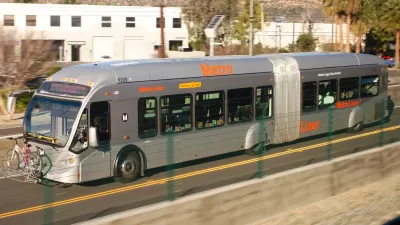The Bus Rapid Transit System has failed to meet the demands of New Delhi's riders and pedestrians. A better strategy, according to one report, is to improve its mass transit instead.
"The Standing Committee observation came in the light of a report submitted by School of Planning and Architecture head Prof P K Sarkar, who has highlighted a number of 'loopholes' in the Delhi model of BRT. In his observations, Prof Sarkar has pointed out that one of the major failures of this transport model in Delhi has been to take away seven metres of road width from the already inadequate right of way of the road.
According to the expert's observations, even before the BRT system was implemented, the road, divided into six lanes, experienced very heavy traffic volume for most part of the day. The stretch needed to be widened to handle that traffic volume even before the BRT idea was implemented, the report says. But instead of adding width, two lanes were taken out of the corridor, the report points out.
According to the committee, the passenger carrying capacity of the BRT model in Bogota (Colombia) is higher due to more road space given to cars. But in Delhi, 'even movement of pedestrian traffic across the BRT corridor is not well planned'. Result: pedestrians have to walk comparatively longer distances to cross the corridor, the report says."
FULL STORY: Delhi should abandon its ‘failed BRT’ model: panel

Alabama: Trump Terminates Settlements for Black Communities Harmed By Raw Sewage
Trump deemed the landmark civil rights agreement “illegal DEI and environmental justice policy.”

Planetizen Federal Action Tracker
A weekly monitor of how Trump’s orders and actions are impacting planners and planning in America.

The 120 Year Old Tiny Home Villages That Sheltered San Francisco’s Earthquake Refugees
More than a century ago, San Francisco mobilized to house thousands of residents displaced by the 1906 earthquake. Could their strategy offer a model for the present?

In Both Crashes and Crime, Public Transportation is Far Safer than Driving
Contrary to popular assumptions, public transportation has far lower crash and crime rates than automobile travel. For safer communities, improve and encourage transit travel.

Report: Zoning Reforms Should Complement Nashville’s Ambitious Transit Plan
Without reform, restrictive zoning codes will limit the impact of the city’s planned transit expansion and could exclude some of the residents who depend on transit the most.

Judge Orders Release of Frozen IRA, IIJA Funding
The decision is a victory for environmental groups who charged that freezing funds for critical infrastructure and disaster response programs caused “real and irreparable harm” to communities.
Urban Design for Planners 1: Software Tools
This six-course series explores essential urban design concepts using open source software and equips planners with the tools they need to participate fully in the urban design process.
Planning for Universal Design
Learn the tools for implementing Universal Design in planning regulations.
Clanton & Associates, Inc.
Jessamine County Fiscal Court
Institute for Housing and Urban Development Studies (IHS)
City of Grandview
Harvard GSD Executive Education
Toledo-Lucas County Plan Commissions
Salt Lake City
NYU Wagner Graduate School of Public Service



























